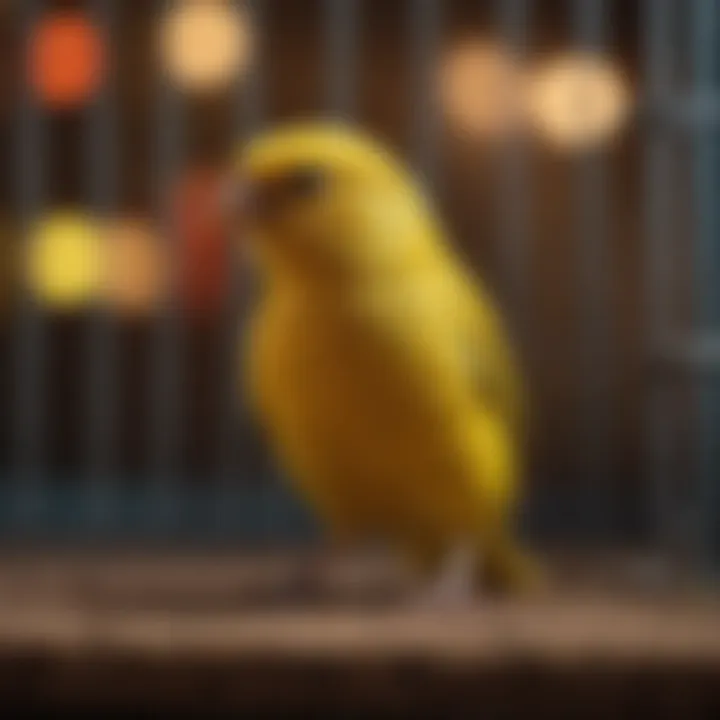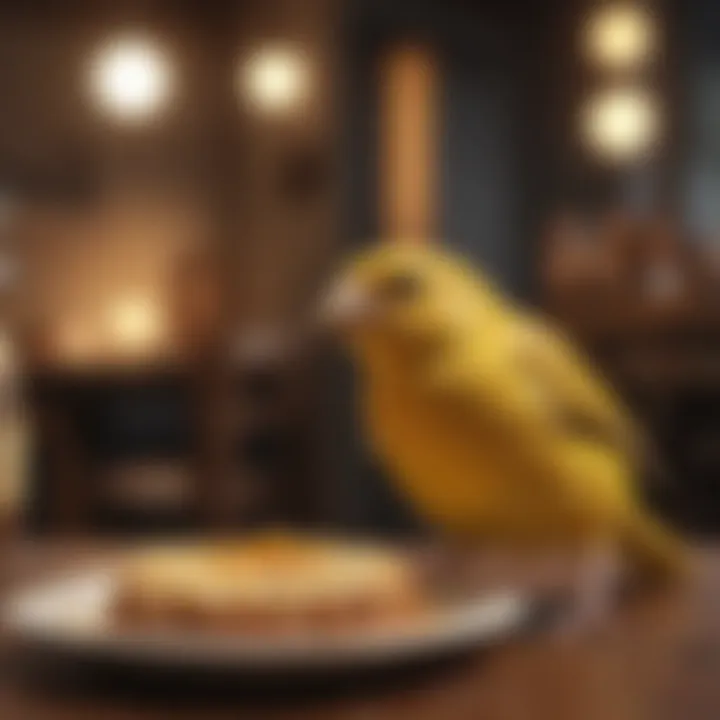Exploring the World of Live Canaries for Sale


Intro
Canaries have long since charmed many with their delightful songs and vibrant plumage. As potential pet owners or enthusiasts, understanding what makes these creatures tick is fundamental for informed decisions. This article will explore the various aspects of live canaries available for sale, shedding light on their unique characteristics and care requirements. Whether you're considering adding a canary to your family or you’re already smitten, a comprehensive understanding can enrich your experience and connection with these feathered friends.
Understanding Your Pet
Pet Behavior Basics
Canaries are social birds that thrive in an environment filled with interaction and positive energy. They often express themselves through various vocalizations, and surprisingly, some can learn to mimic sounds from their surroundings. It's essential to tune in to their moods; a chirpy canary might be at its happiest, while a quiet one could be feeling under the weather or simply enjoying some solitude.
Common Breed Characteristics
There are numerous canary breeds, each boasting its own flair. For instance:
- Harlequin: These beauties are known for their vibrant colors and distinct patterns.
- Gloster: With their unique crest, Glosters often catch the eye and have a charming personality to match.
- Lizard: This breed, named for its unique feather structure, is both beautiful and curious.
Each breed carries its own traits and particularities, making them interesting companions.
Species-Specific Needs
Canaries require proper care specific to their species. They need a well-balanced diet, a clean cage environment, and regular time out of their cages to stretch their legs. Each species may exhibit preferences for different types of food; for example, some may enjoy a seed-based diet while others thrive on pellets enriched with vitamins and minerals. Observing your canary helps understand and meet its particular needs, ensuring a happy and healthy pet.
Pet Care and Maintenance
Feeding Guidelines
Feeding your canary the right diet is crucial to its well-being. A varied dietary regimen should consist of:
- High-quality seeds
- Fresh fruits and vegetables
- Occasional treats like cuttlebone for calcium
Always remember to refresh water daily, keeping it clean and accessible.
Grooming Essentials
Grooming goes beyond just keeping their feathers looking good. Regularly checking the nails and beak ensures they don't overgrow. Some canary owners choose to provide a shallow dish for bathing, as canaries enjoy splashing around to keep their feathers in pristine condition.
Hygiene Practices
Maintaining a clean living environment for your canary is non-negotiable. Regularly changing cage liners and cleaning food and water dishes weekly helps prevent the buildup of bacteria that could lead to illness.
Training and Development
Basic Commands and Skills
Training a canary doesn't involve the typical commands one might associate with dogs. However, you can encourage your canary to interact more by introducing simple training techniques. Using hand gestures and treats can help in establishing trust and encouraging your canary to come to you.
Behavioral Training Techniques
To address any unwanted behaviors, positive reinforcement is key. Offering rewards for good behavior, while redirecting undesirable actions, creates an understanding and strengthens your bond.
Addressing Common Behavior Issues
Sometimes canaries may exhibit stress-related behaviors, like excessive plucking. It can stem from various factors—environmental changes or loneliness. Creating a calm and secure space can mitigate anxiety-driven habits.
Health and Wellness
Routine Vet Check-ups
Regular veterinary checkups are crucial. An avian vet can provide guidance tailored to your canary’s specific needs, ensuring proactive health management.
Vaccination Needs
While canaries don’t usually require standard vaccinations like other pets, preventative care, such as parasite management, should not be overlooked. Make sure to consult with your vet periodically.
Recognizing Signs of Illness
Keeping an eye out for typical signs of illness like changes in appetite, feather appearance, or social behavior can greatly aid in early detection of potential challenges. As the saying goes, a watched canary may avoid being sick.
Enrichment and Activities
Indoor vs. Outdoor Activities
Indoor activities can include letting your canary explore different safe spaces while under supervision, providing a flat surface to hop around. On the other hand, if possible, supervised outdoor time can grant them fresh air and new sights, promoting overall happiness.
Interactive Toys and Games
Canaries enjoy toys that promote physical activity and mental stimulation. Provide shreddable materials, mirrors, or bells to keep them engaged. Rotating the toys frequently can prevent boredom and keep their spirits high.
Socialization Opportunities
Socialization with other birds should be approached cautiously. If introducing more than one canary, gradual introductions are best to avoid territorial disputes. Sometimes, they might find companionship with other similarly sized birds, nurturing their social nature.
In sum, understanding the intricate details about canaries fosters a rewarding companionship that transcends the ordinary pet-owner relationship.
Foreword to Canaries
Canaries are small, vibrant birds that have captured the hearts of many around the world. Understanding their significance not only enhances the experience of owning them but also sheds light on their fascinating history and role in human culture. This section aims to delve into what makes these feathered friends a popular choice for pet enthusiasts and why they deserve special consideration in the realm of pet ownership.
Historical Background of Canaries
The story of canaries begins in the Canary Islands, where they were first discovered around the 15th century. These birds, originally a wild species, quickly attracted the attention of sailors and explorers, who brought them back to Europe. At that time, canaries were valued not just for their appearance but also for their captivating songs. As they became domesticated, selective breeding started, leading to the creation of various breeds that boasted distinct colors and melodious tunes.
Today, canaries are not only recognized for their aesthetic appeal but also for their role as companions. Each breed offers a unique charm, making them an excellent choice for individuals seeking both beauty and song in their homes.


Understanding the Canary's Role in Human Culture
Throughout history, canaries have symbolized a range of concepts in human society. Often viewed as harbingers of joy, their cheerful melodies can brighten anyone's day. They also represent loyalty and companionship; many families find comfort in these small creatures as they bring a sense of warmth and life into their homes.
In the mining industry, canaries were utilized as safety monitors. Miners would take these birds underground to detect hazardous gas levels, thanks to their sensitivity to air quality. This practice, while no longer in use, showcased the invaluable role that canaries played in human industry and survival.
From their origins in the wild to their domestication and multifaceted roles in society, canaries have certainly carved out a niche in human culture. Knowing this context not only enriches our understanding of these delightful birds but also highlights the responsibilities that come with their ownership. As potential owners consider bringing a canary into their lives, reflecting on their history and cultural significance can provide a deeper appreciation and commitment.
"Owning a canary isn't just about petkeeping; it's about embracing a tradition that has fluttered through the ages."
In summary, comprehending the roots and cultural implications of canaries is essential for anyone considering these charming birds as pets. Their history and significance set the stage for the various breeds available today and the care they require as beloved companions.
Different Breeds of Canaries
When it comes to keeping canaries as pets, understanding the different breeds is crucial. Each breed has its own unique traits and characteristics, which can greatly affect a pet owner's choice based on personal preference and living conditions. This section dives into the most recognized categories—song canaries, color canaries, and type canaries. By examining these categories, potential owners can make informed decisions that suit their lifestyle while ensuring their feathered friends thrive.
Song Canaries
Song canaries are, as the name suggests, valued primarily for their melodious singing abilities. They exhibit striking vocalizations that can range from vibrant melodies to soft whistling. Their songs can bring joy and serenity to a home, making them a popular choice for many.
American Singer
The American Singer is renowned for its captivating melodies, making it a top pick among songbird enthusiasts. These canaries often possess a gentle disposition, allowing them to easily adapt to different environments. Their singing is described as rich and varied, showcasing an impressive vocal range.
One might say the American Singer truly steals the show with its vocal abilities. However, it's worth noting that they can be somewhat sensitive animals. Excessive noise or disturbances may affect their singing, possibly leading to stress. On the plus side, they are relatively easy to care for and bond well with their owners, making them a delightful addition to any family.
Harz Roller
The Harz Roller stands out among song canaries for its beautiful, rolling song pattern. Originating from the Harz mountains in Germany, these canaries are not just admired for how they sing, but also for their graceful appearance. They are typically calm and docile, thriving in peaceful settings.
What’s unique about the Harz Roller is its ability to produce a series of rounded tones that many find soothing. Their vocalization is not only melodious but consistent, which appeals to those seeking a more calming ambiance. The caveat? They might require particular environments to reach their full vocal potential, necessitating a dedicated effort from their caretakers to ensure optimal conditions.
Border Fancy
The Border Fancy, with its enchanting barely-there song, often attracts those who appreciate a more gentle sound. This breed is characterized by its attractive plumage and stocky build. Their friendly demeanor makes them sociable companions.
An interesting aspect of the Border Fancy is its aesthetic appeal. It’s often considered one of the most visually charming canaries, boasting a variety of colors and intricate feather patterns. However, while they sing beautifully, their vocal prowess is not as robust as that of the American Singer. Therefore, they may be better suited for those who want a lovely display bird rather than a full-time songbird.
Color Canaries
Color canaries are bred specifically for their vibrant hues. The aesthetics of these birds can truly brighten up any space, which is why they capture the hearts of many bird lovers. From soft pastels to bold reds, the spectrum of colors is vast and impressive.
Lizard Canary
The Lizard Canary is a remarkable breed known for its unique, scaly feathering that resembles the skin of a lizard, hence the name. Apart from its visually striking appearance, this breed is also celebrated for its vibrant colors that add flair to aviaries.
Owning a Lizard Canary offers the charm of observing their distinctive patterns, making them a favorite among collectors. However, their rarity can pose challenges as they are not always readily available, which may affect enthusiasts looking to add them to their flock.
Red Factor Canary
The Red Factor Canary is famous for its enchanting shades of red, stemming from its diet that includes carotenoid-rich foods. These canaries are well-loved not just for their color, but also for their playful personalities that often entertain their owners.
However, maintaining the deep red coloration of a Red Factor Canary requires diligent care. Owners must provide a specialized diet to maintain their vibrant hues. Lack of the right nutrients can lead to duller colors, which could be disappointing for those who seek a striking visual impact in their cages.
Baltimore Canary
The Baltimore Canary is another color variety that stands out, often found flaunting beautiful combinations of yellow and orange. Their stunning colors make them a popular choice among bird breeders and pet owners seeking to enhance their bird collection.
Much like the Red Factor, the Baltimore Canary demands specific dietary needs to preserve its coloration. They need regular exposure to sunlight, which may require strategic positioning of their habitat, hence extra attention to their care.
Type Canaries
Finally, we arrive at type canaries, which are bred primarily for their physical characteristics rather than song or color. These canaries often add a unique appeal to any collection, showcasing fascinating shapes and sizes.
Gloster Canary
The Gloster Canary is quite distinctive, characterized by its rounded head and compact body. This breed is known for its friendly nature and is a favorite among families.
Notably, the Gloster often stands out in an aviary for its unique head feathers, further contributing to its charm. However, some may find their temperament can be a bit timid, which can be an aspect to consider for households with active children.
Norwich Canary
Known for its robust and sturdy build, the Norwich Canary is a classic example of type canaries. These birds have a dense feather structure, often making them appear even larger than they are.
Their quiet disposition and strong presence can be comforting in various settings, but they may require a larger space compared to others. This can give potential owners pause, especially in smaller living areas.
Yorkshire Canary
Last but not least, the Yorkshire Canary is recognized for its tall stance and elegant feathers. They have a somewhat aristocratic air about them, making them stand out in any gathering.
While highly regarded for their beauty, they do require attentive grooming to maintain their impressive plumage. This can demand extra effort, but for many enthusiasts, the investment in their care is well worth it to witness their stunning appearance.
Keeping canaries offers personal satisfaction not only from their beauty and singing but also from the connection formed with such captivating creatures. This is something that all potential owners should cherish.
Ultimately, selecting the right breed of canary involves understanding their unique traits and how they fit within the context of your home and lifestyle. This knowledge will guide you toward making a choice that resonates most with your preferences, ensuring a joyful experience for both you and your future avian companion.
Factors to Consider Before Purchase
When it comes to inviting a canary into your life, there’s a lot more than just picking the prettiest feathered friend on display. Thoughtful consideration of various factors before diving into a purchase can make a world of difference. After all, these delightful creatures deserve an environment that meets their needs, a proper diet, and a chance to thrive amidst the human family.
Living Environment Requirements
Let’s start off with the living conditions. Canaries aren’t too fussy, but they definitely appreciate a comfortable and stimulating environment. A spacious cage is a must; aim for one that offers enough horizontal space for them to spread their wings and flit about. Look for a cage that is at least 24 inches wide for a couple of canaries. Along with size, ensure it has bars that are close enough to prevent escapes—think along the lines of one-half to three-quarter inches apart.


- Location, Location, Location! Position the cage in a quiet area but with access to natural sunlight. Canaries love light, and a well-placed cage promotes their mental well-being.
- Appropriate Temperatures: Keep the room temperature within 65 to 75 degrees Fahrenheit. They aren’t fans of drafts or extremes; a cozy spot works wonders.
Don't forget about enriching their surroundings! Add some toys, perches at different heights, and perhaps even a few safe plants to make them feel at home. A lively setup can bring your canary’s personality to life.
Canary Diet and Nutrition
Now, let’s talk turkey—but, in this case, let’s talk seeds, greens, and everything in between. Canaries are seed eaters, and while commercial seed mixes are available, it’s crucial to understand that variety is key to their health. A balanced diet generally includes:
- High-Quality Seed Mix: Look for blends specifically for canaries, ideally containing millet, canary seed, and oats.
- Fresh Fruits and Vegetables: These are your pals. Offer them chopped carrots, spinach, apples, or even broccoli. Just skip the avocado; it’s a no-go for canaries.
- Pellets: Consider adding high-nutrient pellets that serve as a supplement to their main diet. This can help provide essential vitamins and minerals they might be missing from seeds alone.
In addition to food, ensuring they have access to clean water every day is non-negotiable. Keep that water fresh and clean to promote good hydration and overall health.
Socialization Needs of Canaries
Canaries are social creatures by nature. While some may be fine with solitary lives, many thrive in the company of others—whether that’s another canary or humans! Understanding their socialization needs is critical for a happy bird.
- Companion Birds: If you choose to keep only one canary, be prepared to invest time in interaction. Play with them, talk to them, and provide mental stimulation—these are all essential for their emotional health.
- Introducing New Friends: If you have space and resources, consider adopting two canaries. However, be cautious when introducing them to prevent conflict. Gradual introductions work wonders.
The companionship of their own kind can encourage a happier, more active demeanor. Personality traits such as singing and playfulness often find themselves magnified in a social setting.
"Canaries are more than vibrant feathers and sweet songs; they are companions that thrive on interaction and understanding."
Acquiring Live Canaries
Acquiring a live canary is not just about buying a pet; it’s about nurturing a creature that brings joy, song, and color into your home. In this section, we will explore various elements that are crucial when considering the purchase of these delightful birds. Understanding the channels available for acquisition can save potential owners from pitfalls and ensure a rewarding experience, both for the buyer and the canary itself.
Reputable Breeders vs. Pet Shops
When it comes to acquiring a canary, it's essential to weigh the pros and cons of reputable breeders against standard pet shops. Reputable breeders often specialize in specific breeds and can provide a wealth of information on care and characteristics. They usually prioritize the health and lineage of their birds. This means that not only are the canaries typically in better health, but they also come with documentation of their breeding history.
Conversely, pet shops may offer a broader selection of canaries but often lack comprehensive knowledge about the birds they're selling. Some may have birds sourced from various places, leading to inconsistent health and lineage.
"Choosing the right source for your canary can make a world of difference in your bird's health and happiness."
Before buying a bird, visit the breeder or shop, and observe the conditions. Key considerations include:
- Cleanliness of the living environment
- Behavior of the birds (are they active and curious?)
- Health indicators (look for clear eyes and clean feathers)
- Documentation of genetic background (especially important for show canaries)
Online Resources for Purchasing Canaries
With the digital world booming, purchasing a canary online has become an increasingly popular avenue. There are several respected platforms and forums where interested buyers can find canaries for sale. Websites such as BirdBreeders.com and BirdsNow.com are treasure troves filled with listings from reliable sellers.
However, caution is key. Prospective buyers should ensure that the online seller supports responsible breeding practices. Here are some tips:
- Research vendors thoroughly before making any commitments.
- Look for customer reviews and feedback on forums like Reddit or Facebook groups.
- Always ask for health guarantees, and don’t hesitate to ask questions about the canary’s diet, temperament, and care prior to purchase.
Adoption Options for Canaries
Consider adopting a canary from a rescue organization or local shelter. Many birds need homes due to various reasons, often unrelated to their health or behavior. Adoption is an ethically sound choice that not only provides a home to a bird in need but can also be rewarding for the new owner.
Benefits of adoption:
- Cost-effective compared to purchasing from breeders or shops
- Supporting ethical practices in pet ownership
- Potentially receiving a canary that is already socialized and accustomed to family life
Before adopting, research local rescue organizations or check out national resources. Make sure to ask about the bird’s history and any special care requirements it may have.
In summary, whether you choose a reputable breeder, a pet shop, or an adoption route, each avenue has its attributes and considerations. Understanding these facets will lead to a more informed and enriching experience in bringing a canary into your life.
Pricing of Canaries
When it comes to welcoming a canary into your home, understanding the pricing of canaries is a crucial factor that cannot be overlooked. The cost of these delightful companions can vary due to several elements, and knowing these can help you make an informed decision. It's not just about showing off a cute face; it's about ensuring you can provide a proper, loving environment for your new pet. In a world where everything seems to come with a price tag, canaries are no exception, and their prices tell you a lot about what to expect from your new feathered friend.
Factors Influencing Canary Prices
There are several aspects that come into play when determining how much you might pay for a canary. These factors can include:
- Breed Popularity: Some breeds, like the American Singer, are well-loved and tend to command a higher price just because of their reputation. Others, like the common yellow canary, might be more budget-friendly due to their widespread availability.
- Age and Quality: A young, well-bred canary from a reputable breeder often costs more than an older canary or one found in a pet shop. High-quality birds with good lineage will always have a higher price tag.
- Color Variation: Color can significantly affect price. Color canaries, such as the Red Factor Canary, may be priced higher than your average common canary because of the genetic traits required to produce their vibrant shades.
- Health Status: Birds that have been thoroughly health-checked and come with a valid health guarantee tend to be pricier. Investing in a healthy bird saves you costs on potential veterinarian bills down the line.
"When considering a canary, think about the price as a reflection of the care and quality you get in return."
Average Costs of Different Canary Breeds
The market offers a varied price range for different canary breeds, demonstrating that not all canaries are created equal. Here’s a brief overview of average costs:
- Song Canaries
- Color Canaries
- Type Canaries
- American Singer: Ranges between $100 to $250 depending on lineage and singing quality.
- Harz Roller: Typically goes for around $100 to $200.
- Border Fancy: This breed's price can hover around $150 to $300 due to its exquisite appearance.
- Lizard Canary: Known for its unique plumage, it generally costs around $75 to $200.
- Red Factor Canary: This one can be a bit pricier, usually ranging from $150 to $300 due to its striking red hue.
- Baltimore Canary: Sits at about $100 to $250 depending on the breeder.
- Gloster Canary: Often starts at $100 but may go higher for show-quality birds.
- Norwich Canary: Usually found for around $80 to $150.
- Yorkshire Canary: This breed may reach $200 or beyond, particularly for champion show birds.
Understanding these pricing dynamics can help steer your purchase decisions. Ultimately, it’s about finding the right balance between what you can afford and ensuring your furry friend will have a healthy environment to thrive in.
Canary Care Essentials
Taking care of canaries goes well beyond simply providing food and water. It's a multifaceted responsibility that requires attention to their habitat, diet, health, and overall well-being. Understanding the essentials of canary care is crucial, not just for the health of the birds themselves, but also for the enjoyment and satisfaction of the owner. A well-cared-for canary can bring life to a home with its song and vibrant colors, making every effort put into its care worthwhile.
Creating a Healthy Habitat
First and foremost, the habitat you create for your canaries sets the stage for their happiness. A well-designed cage should be spacious enough for them to stretch their wings and flit about without restrictions. Cage dimensions matter significantly; a common recommendation is to opt for a cage that is at least 18"x18"x24" for a pair of canaries.


Considerations for Habitat Design:
- Cage Bar Spacing: Bars should be spaced around ½ inch apart to prevent escapes or accidental injury.
- Perches: Use a variety of perch sizes made from natural materials like wood. This not only supports their foot health but also encourages them to exercise.
- Toys: Adding bells, swings, or even simple cardboard boxes can provide mental stimulation. Canaries are naturally curious and thrive on interaction with their environment.
Maintaining cleanliness is key. Regularly clean the cage, removing waste and uneaten food to prevent any health issues. Additionally, positioning the cage in a well-lit and adequately ventilated area, away from drafts and direct sunlight, is essential.
"A clean cage is a happy cage, and a happy cage means a happy bird."
Regular Health Checkups and Grooming
Canaries, like any pet, require periodic health checkups. Regular health examinations can help catch potential issues before they escalate. You might not be able to spot problems right away, but routine checks promote early identification of conditions such as respiratory diseases or feather plucking.
When it comes to grooming, keep their feathers in check. Generally, canaries are good self-groomers; however, you may notice some fluff or stubborn dirt that they can't reach. Lightly misting them with clean water can help, especially during molting seasons when they need help maintaining the condition of their plumage.
Some grooming essentials include:
- Nail Trimming: If their nails get too long, they may struggle to perch comfortably. Trimming should be done with caution to avoid cutting into the quick.
- Beak Care: A canary's beak should be referred to as mostly self-maintaining, but it’s advisable to monitor it for overgrowth or unusual coloration.
In essence, ensuring your canary's health involves a blend of proper habitat, regular checks, and proactive grooming. The investment you make into their care reflects directly on their well-being and quality of life.
Understanding Canary Behavior
Understanding how canaries behave is vital for anyone thinking about bringing these lively birds into their home. Knowing their natural instincts and tendencies can help create a harmonious environment for both the canary and its owner. Canaries are not just amusing pets; they have their peculiarities that, once acknowledged, can enhance the relationship between bird and owner.
Common Behavioral Traits of Canaries
Canaries exhibit a range of behaviors that reflect their playful, curious natures. Here are some common traits:
- Singing: It's nearly impossible to discuss canaries without mentioning their melodious voices. Male canaries are known for their singing, especially during breeding season. Their songs can vary from sweet melodies to complex tunes, often reflecting their mood.
- Exploration: Canaries are natural explorers. They love to fly around their enclosures, perching on different spots. Providing a stimulating environment is key, as boredom can lead to unwanted behaviors.
- Social Interaction: While canaries can be independent, they also enjoy socializing, either with other birds or their humans. They often communicate with subtle body language, making it exciting to bond with them. Some can also mimic sounds from their environment!
- Preening Behavior: Canaries spend considerable time preening their feathers, an instinctual activity that keeps their plumage in top-notch condition. This behavior is important for health and comfort, as it helps maintain feather health and reduces stress.
Being aware of these traits allows owners to create an inviting habitat tailored to meet their needs, particularly regarding social interactions and physical activity.
Managing Behavioral Issues
Despite their many charms, canaries can exhibit behavioral problems if their environment is not conducive to their instincts. Here’s how to manage these issues effectively:
- Acknowledge Signs of Stress: Pay attention to behaviors like excessive screaming or plucking feathers. These may indicate stress due to inadequate space, lack of companionship, or environmental discomfort.
- Provide Enrichment: Boredom can lead to bad habits. Engage your canary by incorporating toys, perches of varying heights, and opportunities for safe exploration. Items like mirrors, bells, and swings can greatly enhance their habitat.
- Regular Interaction: Spend time with your canary daily. Gentle talking and whistling can help your bird feel secure and less anxious. Remember, even the most independent canary appreciates a good chat!
- Observe Dietary Needs: Sometimes, behavioral issues stem from inadequate nutrition. Ensure your canary is on a balanced diet, including seeds, pellets, fresh fruits, and vegetables. A hungry bird can become irritable, just like us!
"Understanding the personality of your canary is as crucial as meeting their physical needs; both play roles in their overall well-being."
By actively managing behaviors, owners can pave the way for a joyful sharing of space with their feathered friends, ensuring a rewarding experience. Understanding these dynamics fosters a fulfilling bond and minimizes behavioral concerns.
Integrating Canaries into Family Life
Integrating canaries into family life can be as rewarding as it is complex. These vibrant little birds bring beauty, color, and delightful music into a home. Their strong social nature makes it critical for potential owners to thoughtfully consider how best to create a harmonious environment for all members, both feathered and human. The right approach to integrating canaries can foster a nurturing atmosphere that celebrates the joy of pet ownership while also considering the needs of existing family dynamics.
Introducing Canaries to Other Pets
Bringing a new pet into a home, especially one as delicate as a canary, requires a strategic approach, especially if there are other pets around. Understanding the natural instincts of your pets is crucial. For instance, cats are wired to hunt, and birds are seen as prey. It's essential to supervise interactions carefully and perhaps maintain physical barriers, such as keeping the canary’s cage in a secure spot where other pets can’t access it easily. Doing so not only protects the canary but also helps reduce stress on all involved.
- Start Slow: When introducing your canary to other pets, allow them to gradually adjust. Let your pet observe the canary from a distance first.
- Use Positive Reinforcement: Reward any calm behavior around the cage with treats or praise. This helps promote a sense of safety.
- Create Safe Spaces: Ensure that your canary has places to retreat to, even if that’s just within their cage, if they feel overwhelmed by other animals.
This careful introduction can lead to a surprising camaraderie. Some families have even reported their dogs learning to coexist peacefully with their canaries, while other pets simply enjoy watching them fly and sing.
The Impact of Children on Canary Care
Childern can be enthusiastic companions for pet birds, but it is paramount to instill a sense of responsibility early on. Teaching kids about canaries not only helps them bond with the pet but also educates them on the significance of gentle handling. Letting children assist with basic care tasks—like changing water or filling a feeder—can foster a sense of achievement. However, it’s crucial to supervise these interactions initially.
- Set Rules: Establish guidelines for handling the canary and respecting its space. Kids must learn to be gentle and calm around the bird to avoid shocking it.
- Encourage Learning: Share fascinating facts about canaries to spark interest and deepen their understanding.
- Create a Structured Routine: Having set times for feeding, cleaning, and playing can teach children discipline while also ensuring the bird's needs are met consistently.
“Bringing a canary into a home with children can be delightful—just like caring for any living being, it demands patience, education and attention to ensure everyone thrives.”
Thus, while children can enliven a household, the importance of guiding them in their interactions with the canary cannot be overstated. Establishing firm yet nurturing practices can lead to an enriching pet-owning experience where both children and birds benefit significantly.
Ethical Considerations in Canary Ownership
When it comes to owning a live canary, ethical considerations shouldn't be brushed under the carpet. The importance of this topic goes beyond just having a cheerful bird in your home. Owning a pet comes with the responsibility of ensuring their well-being, which is fundamentally crucial in the case of canaries. Ethical ownership starts with understanding the breed characteristics, their natural habitats, and providing the right environment for them to thrive. By paying attention to these elements, you not only contribute to the health of your pet, but also to the conservation of the species as a whole.
The Importance of Ethical Breeding
Ethical breeding is a fundamental pillar in the world of canaries. This concept encompasses practices that prioritize the health and welfare of the birds over mere profit. For prospective owners, it's imperative to select breeders who adhere to such ethical guidelines. A good breeder ensures that their breeding is not just about producing a bird with desirable colors or singing abilities, but also about maintaining genetic diversity and reducing the risk of inherited health problems.
- Health focus: Ethical breeders often conduct health screenings and genetic tests on their birds, helping to minimize the chances of passing on hereditary conditions.
- Socialization: A responsible breeder will expose their birds to various stimuli and social situations, laying the groundwork for a well-adjusted pet.
- Transparency: When breeders are open about their practices and willing to provide information on the health history of their birds, it's a positive sign that they take their role seriously.
"Choosing a bird from an ethical breeder sets the stage for a positive pet-parent relationship—one built on trust and care."
Rescue and Rehabilitation Options
Another important aspect of ethical canary ownership lies in considering rescue and rehabilitation options. Many canaries end up in shelters due to unforeseen circumstances; understanding this can lead to a rewarding experience for both bird and owner. Adopting a rescue canary is not just a feat of compassion; it often leads to the opportunity to give a second chance to a bird that may have faced neglect or abuse.
- Finding a Rescue: Many local animal shelters and rescue organizations focus specifically on birds. Websites like Facebook groups or even Reddit can serve as platforms to find these organizations in your area.
- The Adoption Process: Typically, adopting a canary from a rescue involves a screening process. Be prepared to explain your living situation and the care you can provide. Some rescues may require a small fee which helps with the care of the birds.
- Support Systems: Once adopted, it's essential to continue to support the rescue's mission. Spreading the word about available canaries or even making donations can make a significant difference in the lives of these animals.
Finale and Final Thoughts
In wrapping up this extensive exploration of live canaries available for sale, it’s crucial to reflect on what has been discussed and its significance for potential owners and enthusiasts alike. Understanding the characteristics, needs, and ethical considerations surrounding canaries is not just an intellectual exercise—it's a practical necessity for anyone looking to welcome these feathered friends into their homes.
The journey through various breeds, their behavior, and the requirements for care highlights that canaries are not just beautiful pets; they are intelligent creatures with individual personalities and needs. Each breed, from the harmonious songs of the American Singer to the striking colors of the Red Factor Canary, offers something unique, which can deeply enrich the lives of their owners.
One significant consideration is the ethical responsibility involved in canary ownership. Many individuals might overlook this, but choosing to adopt or purchase from reputable breeders can significantly influence the overall well-being of the species. It’s about more than just having a bird; it’s about ensuring those birds are treated with respect and care, a concept that resonates deeply in today’s consumer-driven world.
Moreover, integrating canaries into family life requires forethought and planning. The dynamics of having pets, especially for families with children, necessitate understanding potential behavioral issues and the social needs of these birds. The lessons we take away from caring for a canary—patience, understanding, and an appreciation for life’s simpler joys—enrich not only our lives but also those of our children.
Remember the benefits of having a canary around—whether it's the tranquil ambiance their songs create or the joy they bring as you watch them flit about their cage. This companionship is profound and teaches important life lessons to anyone willing to open their hearts and homes.
"Birds teach us that we can soar to new heights when we are nurtured and understood."
As you embark on this journey, whether you are a seasoned pet owner or contemplating your first purchase, remember the insights shared in this article. Analyze your environment, consider your family's lifestyle, and choose your bird wisely. The world of canaries has much to offer, and with careful consideration, it can lead to a fulfilling relationship with these vibrant creatures.
In essence, responsible ownership begins with informed decisions, and that understanding will ultimately shape a rewarding experience for both you and your future canary.







